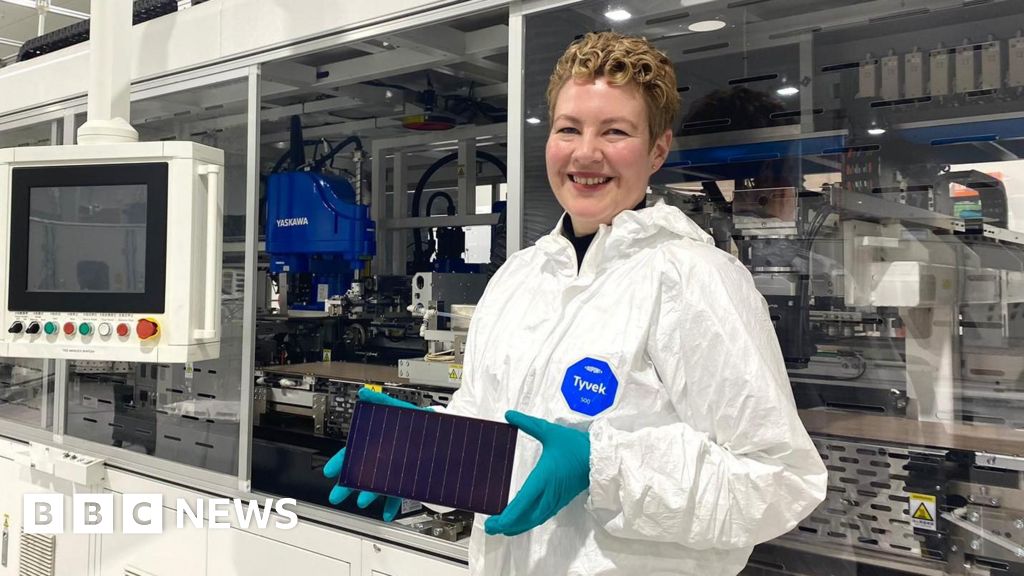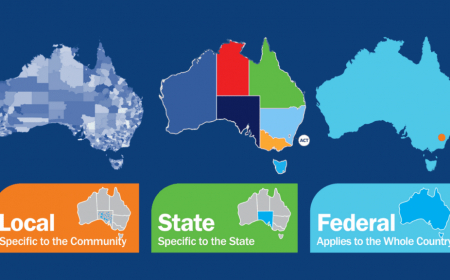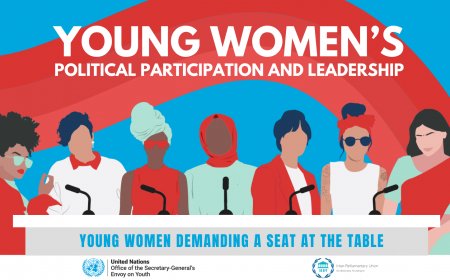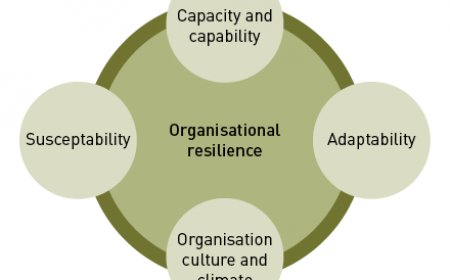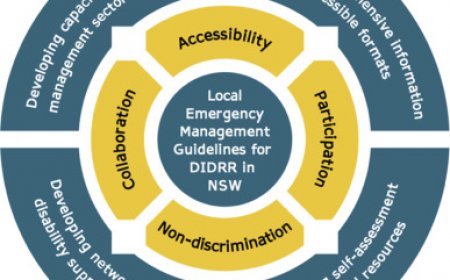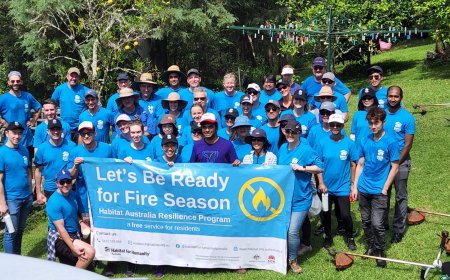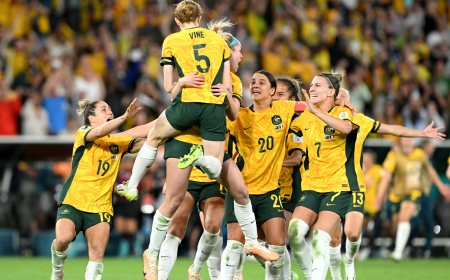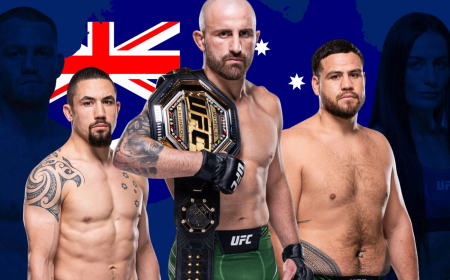Australia Soccer Fever: Whats Driving the Passion?
Discover what drives Australia's soccer fever! Explore the history, key influencers, technological advancements, and global impacts shaping the sport's rise in popularity. Engage with insights into the A-League, Socceroos, Matildas, and grassroots initiatives fueling this nationwide passion.
Soccer in Australia has undergone a remarkable transformation over the past few decades, evolving from a niche sport into a cultural phenomenon. The rise of Australia soccer fever is not merely a fleeting trend but rather a reflection of deeper societal shifts and strategic initiatives that have reshaped the sporting landscape. As we delve into this topic, it becomes evident that the passion for soccer in Australia is driven by a combination of factors—ranging from grassroots development to international exposure—that have collectively fueled its meteoric rise.
The A-League , Australia's premier soccer competition, has played a pivotal role in establishing soccer as a mainstream sport. With its inception in 2004, the league brought professionalism and structure to Australian soccer, creating a platform for local talent to shine while attracting global audiences. Beyond the A-League, the success of the Socceroos , Australia’s national men’s team, and the Matildas , the women’s national team, has further galvanized public interest. Their performances on the world stage have not only inspired pride but also demonstrated the potential for Australian soccer to compete at the highest levels.
This article aims to explore the multifaceted reasons behind the growing enthusiasm for soccer in Australia. By examining the historical context, analyzing the impact of key organizations, and highlighting the role of community engagement, we will uncover the elements that have contributed to this nationwide passion. Furthermore, we will address how technological advancements, media coverage, and global influences have amplified the appeal of soccer, making it an integral part of Australia’s cultural fabric.
As we navigate through these discussions, it is crucial to recognize that the fervor surrounding soccer in Australia is not confined to elite competitions or professional players alone. It permeates every level of society, from schoolyards to suburban parks, where countless Australians engage with the sport daily. This widespread participation underscores the universal appeal of soccer and highlights its unique ability to unite people across diverse backgrounds. Through this comprehensive exploration, we aim to provide insights into why soccer has captured the hearts of so many Australians and what the future holds for this dynamic sport.
Historical Evolution of Soccer in Australia
To fully appreciate the current state of soccer in Australia, one must first understand its rich and complex history. Soccer, often referred to as football globally, was introduced to Australia in the late 19th century by British immigrants who brought with them their love for the game. The sport quickly gained traction among working-class communities, particularly in urban centers like Sydney and Melbourne. However, despite its early popularity, soccer struggled to establish itself as a dominant force in the Australian sporting landscape due to competition from traditional sports such as Australian Rules Football and rugby.
The formation of the Australian Soccer Association (ASA) in 1961 marked a significant milestone in the sport’s development. The ASA sought to unify various regional soccer bodies under a single governing entity, laying the groundwork for organized competitions and structured growth. Despite these efforts, soccer remained largely fragmented during the mid-20th century, with ethnic-based clubs dominating the scene. This ethnic-centric model, while fostering passionate local rivalries, limited the sport's broader appeal and hindered its integration into mainstream Australian culture.
The turning point came in 2004 with the establishment of the A-League , a bold initiative aimed at revitalizing soccer in Australia. Replacing the National Soccer League (NSL), which had suffered from financial instability and declining attendance, the A-League introduced a franchise-based model designed to attract corporate investment and elevate the sport’s profile. This restructuring coincided with Australia’s decision to join the Asian Football Confederation (AFC) in 2006, a move that opened new avenues for international competition and exposure. The shift to the AFC not only enhanced the Socceroos' competitive opportunities but also positioned Australian soccer within a larger, more dynamic regional framework.
Another critical chapter in Australia’s soccer history unfolded during the 2006 FIFA World Cup in Germany. The Socceroos’ unexpected run to the Round of 16, highlighted by their dramatic victory over Japan and a hard-fought draw against Croatia, ignited a wave of national pride and renewed interest in the sport. This performance demonstrated that Australian soccer could hold its own on the global stage, inspiring a generation of young players and fans alike. Similarly, the Matildas’ consistent improvement in international tournaments, including their quarterfinal appearance at the 2023 FIFA Women’s World Cup, has further solidified soccer’s place in the national consciousness.
Throughout these developments, the role of government support and private investment cannot be overstated. Initiatives such as the National Curriculum for Youth Development and increased funding for grassroots programs have ensured a steady pipeline of talent. Additionally, partnerships with global soccer powerhouses like Manchester City and Chelsea have brought world-class expertise to Australian shores, elevating coaching standards and player development.
The historical trajectory of soccer in Australia reveals a journey of resilience and reinvention. From its humble beginnings as an immigrant pastime to its current status as a unifying national passion, soccer has overcome numerous challenges to emerge as a cornerstone of Australian sports culture. This evolution sets the stage for understanding the modern drivers of Australia’s soccer fever, which continue to shape the sport’s trajectory today.
The Role of the A-League in Popularizing Soccer
The A-League , established in 2004, has been instrumental in transforming soccer into a mainstream sport in Australia. Designed as a professional franchise-based competition, the league introduced a fresh approach to soccer administration and marketing, addressing many of the shortcomings that plagued its predecessor, the National Soccer League (NSL). By adopting a model similar to successful leagues like Major League Soccer (MLS) in the United States, the A-League prioritized commercial viability, fan engagement, and long-term sustainability. These strategic decisions have not only elevated the quality of play but also cultivated a vibrant soccer culture across the country.
One of the most significant contributions of the A-League has been its ability to attract high-profile players and coaches, both domestic and international. The arrival of marquee signings such as Alessandro Del Piero, Robbie Fowler, and Shinji Ono brought global attention to the league, drawing in fans who were eager to witness world-class talent up close. These players served as ambassadors for the sport, helping to break down barriers and challenge preconceived notions about the quality of soccer in Australia. Moreover, the inclusion of former international stars as coaches—such as Tony Popovic and Graham Arnold—has raised the tactical sophistication of the league, ensuring that matches are competitive and entertaining.
The A-League’s emphasis on community engagement has also played a pivotal role in its success. Each franchise is deeply embedded in its respective city or region, fostering a sense of local pride and identity. Clubs like Melbourne Victory, Sydney FC, and Perth Glory have become synonymous with their communities, organizing outreach programs, youth academies, and fan events that strengthen the bond between the team and its supporters. This localized approach has proven effective in cultivating loyal fan bases, as evidenced by the passionate crowds that regularly fill stadiums during matchdays. The introduction of derby matches , such as the Melbourne Derby and the Sydney Derby, has further heightened the excitement, creating intense rivalries that captivate audiences and generate sustained interest in the league.
In addition to fostering local connections, the A-League has embraced innovative marketing strategies to expand its reach. Social media platforms, digital streaming services, and interactive fan experiences have been leveraged to engage younger audiences and make soccer more accessible than ever before. Campaigns like the “This Is Football” initiative have successfully rebranded the league, emphasizing inclusivity and diversity while appealing to a broader demographic. The A-League’s commitment to gender equality is also noteworthy; the introduction of the A-League Women competition has provided female athletes with a professional platform, inspiring countless young girls to pursue soccer as a career.
Furthermore, the A-League’s alignment with international soccer calendars and its integration into the AFC Champions League have enhanced its credibility on the global stage. Australian clubs now compete against top teams from Asia, exposing players to higher levels of competition and increasing the league’s visibility worldwide. This international exposure has not only benefited the clubs but also reinforced the perception of the A-League as a stepping stone for aspiring players aiming to reach Europe or other elite leagues.
The league’s influence extends beyond the pitch, as it has become a catalyst for economic growth and social cohesion. Hosting major soccer events, such as the annual Australia Cup and international friendlies, generates significant revenue for local economies while promoting tourism. Moreover, the A-League’s focus on multiculturalism reflects Australia’s diverse population, uniting fans from different cultural backgrounds under a shared passion for the sport. This inclusivity has helped dismantle stereotypes and foster a more harmonious sporting environment.
In summary, the A-League has revolutionized soccer in Australia by combining professional excellence with community-driven initiatives. Its ability to adapt to changing market dynamics, embrace technological advancements, and prioritize fan engagement has made it a cornerstone of the nation’s soccer ecosystem. As the league continues to evolve, it remains a driving force behind the growing enthusiasm for soccer in Australia, ensuring that the sport remains a central pillar of the country’s cultural and sporting identity.
The Socceroos and Matildas: Icons of National Pride
The Socceroos and Matildas , Australia’s national men’s and women’s soccer teams, respectively, have emerged as powerful symbols of national pride and unity, captivating audiences both domestically and internationally. Their performances on the global stage have not only showcased Australia’s competitive prowess but also deepened the emotional connection between the sport and its fans. Through their achievements, these teams have transcended the boundaries of athletics, becoming emblematic of Australia’s cultural identity and collective aspirations.
The Socceroos’ journey to prominence began with their qualification for the 2006 FIFA World Cup in Germany, marking their return to the tournament after a 32-year absence. This historic achievement sparked a wave of national euphoria, as millions of Australians rallied behind their team. The Socceroos’ thrilling 3-1 victory over Japan in their opening match, followed by a hard-fought draw against eventual champions Italy, cemented their status as underdogs capable of defying expectations. Such moments of triumph resonated deeply with fans, fostering a sense of pride and belonging that transcended age, gender, and geography. The team’s subsequent appearances in the 2010, 2014, 2018, and 2022 World Cups have further solidified their legacy, reinforcing soccer’s position as a unifying force in Australian society.
Equally compelling is the rise of the Matildas, whose rapid ascent in international soccer has earned them widespread admiration. The Matildas’ consistent performances in the FIFA Women’s World Cup , including reaching the quarterfinals in 2023, have highlighted their resilience and skill on the global stage. Players like Sam Kerr, Ellie Carpenter, and Caitlin Foord have become household names, inspiring a new generation of female athletes and challenging traditional gender norms in sports. The Matildas’ success has also played a pivotal role in advancing gender equality within Australian soccer, as evidenced by the growing support for the A-League Women and increased investment in women’s programs.
Beyond their on-field achievements, both teams have become ambassadors for Australia’s multicultural identity. Comprised of players from diverse backgrounds, the Socceroos and Matildas reflect the nation’s rich tapestry of cultures and traditions. This diversity resonates with fans, many of whom see themselves represented in the teams they cheer for. Matches featuring the national teams often serve as communal celebrations, bringing together families, friends, and communities in shared moments of joy and anticipation. Whether it’s watching a World Cup qualifier at a local pub or attending a live match at a packed stadium, the passion for the Socceroos and Matildas unites Australians in ways few other sports can.
The impact of these teams extends beyond the confines of the pitch. Their visibility in international competitions has elevated Australia’s profile on the global stage, showcasing the country’s sporting excellence and fostering diplomatic ties through sport. High-profile matches, such as the Socceroos’ encounters with regional rivals like Japan and South Korea, or the Matildas’ clashes with powerhouse nations like the United States, have drawn significant media attention, amplifying Australia’s presence in the international soccer community. This exposure not only benefits the teams but also contributes to the broader narrative of Australia as a dynamic and inclusive nation.
Moreover, the Socceroos and Matildas have become vehicles for social change, using their platforms to advocate for important causes. From promoting mental health awareness to championing environmental sustainability, these athletes have demonstrated that their influence extends far beyond the game. Initiatives like the Football for All campaign, which seeks to make soccer accessible to marginalized communities, underscore the teams’ commitment to inclusivity and equity. Such efforts resonate deeply with fans, who view their favorite players not just as athletes but as role models and agents of positive change.
The enduring popularity of the Socceroos and Matildas is also reflected in the record-breaking viewership figures for their matches. Broadcasts of World Cup games routinely attract millions of viewers, with fans tuning in from all corners of the country. Social media platforms have further amplified this engagement, as fans share their excitement, debate tactics, and celebrate goals in real-time. The hashtags #Socceroos and #Matildas frequently trend during major tournaments, underscoring the teams’ ability to capture the public’s imagination and sustain interest in soccer year-round.
In essence, the Socceroos and Matildas embody the spirit of Australian soccer, serving as catalysts for national pride and unity. Their achievements on the field, coupled with their off-field advocacy and representation, have transformed them into icons of inspiration and hope. As they continue to compete at the highest levels, these teams will undoubtedly remain at the heart of Australia’s soccer fever, driving passion and enthusiasm for the sport across generations.
Grassroots Development: Nurturing Future Stars
At the core of Australia’s soccer fever lies a robust system of grassroots development, meticulously designed to nurture young talent and instill a lifelong passion for the sport. This foundation is built upon a network of youth academies , school programs , and community initiatives , each playing a vital role in shaping the next generation of soccer players. These programs not only focus on technical skills and tactical understanding but also emphasize values such as teamwork, discipline, and perseverance, ensuring that participants grow both as athletes and individuals.
Youth academies affiliated with A-League clubs serve as the primary incubators for emerging talent. These academies adopt a holistic approach to player development, integrating advanced training methodologies with personalized mentorship. For instance, the Melbourne City Academy and Sydney FC Youth Program offer structured pathways for young players, providing access to state-of-the-art facilities, experienced coaches, and competitive match environments. The academies also collaborate with international partners, such as Manchester City and Juventus, to incorporate global best practices and expose players to diverse playing styles. This cross-cultural exchange enriches the learning experience, equipping young athletes with the versatility needed to excel at higher levels.
School programs complement the work of youth academies by introducing soccer to children at an early age. Organizations like Football Australia have partnered with educational institutions to implement curriculum-based soccer activities, ensuring that students receive regular exposure to the sport. Programs such as the MiniRoos initiative cater specifically to primary school children, offering fun and engaging sessions that focus on fundamental skills like dribbling, passing, and shooting. By embedding soccer into the school environment, these programs create a seamless transition for children who wish to pursue the sport more seriously, while also fostering a broader appreciation for physical activity and teamwork.
Community initiatives further amplify the reach of grassroots soccer, particularly in underserved areas. Non-profit organizations like Kick It and Football United leverage soccer as a tool for social inclusion, targeting marginalized groups such as refugees, Indigenous communities, and low-income families. These programs provide free or subsidized access to training sessions, equipment, and tournaments, breaking down financial barriers that might otherwise prevent participation. Moreover, they emphasize the social and emotional benefits of soccer, using the sport as a medium to build confidence, foster friendships, and promote mental well-being. The success of these initiatives is evident in the stories of participants who have gone on to represent their schools, clubs, or even national teams, proving that talent can thrive regardless of background.
Parental involvement is another critical component of grassroots development. Recognizing the importance of family support, many programs actively engage parents through workshops, volunteer opportunities, and communication channels. This collaboration ensures that children receive consistent encouragement and guidance, both on and off the field. Parents are also educated on the developmental stages of young athletes, helping them understand the balance between pushing for excellence and allowing natural progression. This partnership between programs and families creates a nurturing environment where young players feel empowered to explore their potential without undue pressure.
Technology has further enhanced grassroots soccer by providing innovative tools for training and evaluation. Platforms like Playermaker and FootyFit use wearable devices and mobile apps to track performance metrics, offering detailed insights into areas such as speed, agility, and endurance. Coaches can then tailor training regimens to address individual needs, maximizing the effectiveness of each session. Additionally, virtual coaching resources and online tutorials enable players to continue learning outside formal settings, bridging gaps in access to expert guidance. These technological advancements democratize soccer education, ensuring that even those in remote areas can benefit from cutting-edge methodologies.
The cumulative impact of these grassroots efforts is profound. By investing in youth development, Australia is building a sustainable pipeline of talent that feeds into professional leagues and national teams. Players like Daniel Arzani and Cortnee Vine , who honed their skills through grassroots programs, exemplify the success of this approach. Their journeys from local fields to international stages inspire countless others to dream big and work hard. Furthermore, the emphasis on inclusivity and accessibility ensures that soccer remains a sport for everyone, reflecting the diversity and unity that define Australian society.
In conclusion, grassroots development is the bedrock of Australia’s soccer ecosystem, driving the sport’s growth and popularity from the ground up. Through a combination of structured programs, community engagement, and technological innovation, young Australians are being equipped with the skills, values, and opportunities needed to succeed in soccer and beyond. As these initiatives continue to evolve, they will undoubtedly play a pivotal role in sustaining the nation’s soccer fever for generations to come.
Technological Advancements: Elevating the Soccer Experience
The intersection of technology and soccer has ushered in a new era of innovation, transforming how the sport is played, experienced, and consumed. In Australia, technological advancements have become a cornerstone of the soccer ecosystem, enhancing everything from player performance to fan engagement. These innovations not only elevate the quality of the game but also deepen the connection between fans and their favorite teams, contributing significantly to the growing passion for soccer across the nation.
One of the most impactful technological developments in recent years is the implementation of video assistant referee (VAR) systems. Introduced to the A-League in 2017, VAR has revolutionized decision-making in soccer by providing referees with real-time access to video footage for critical calls. This technology ensures greater accuracy in determining goals, penalties, red cards, and cases of mistaken identity, reducing controversies and maintaining the integrity of the game. For fans, VAR adds an extra layer of transparency and excitement, as they witness pivotal moments being reviewed and resolved on-screen. The adoption of VAR aligns Australia with global standards, reinforcing the A-League’s reputation as a forward-thinking competition.
Another groundbreaking advancement is the use of wearable technology to monitor player performance. Devices such as GPS trackers and smart vests have become indispensable tools for coaches and sports scientists, enabling them to gather precise data on metrics like distance covered, sprint speed, and heart rate. This information allows for tailored training programs that optimize player fitness and minimize the risk of injury. For example, clubs like Melbourne Victory and Western Sydney Wanderers have integrated wearable tech into their routines, ensuring that athletes operate at peak efficiency during matches. Beyond professional teams, wearable devices are increasingly accessible to amateur players, empowering them to track their progress and improve their skills independently.
The rise of data analytics has further transformed soccer, offering unprecedented insights into team dynamics and individual performances. Advanced algorithms analyze vast amounts of match data to identify patterns, predict outcomes, and inform tactical decisions. Teams now rely on analytics to scout opponents, refine strategies, and develop game plans that exploit weaknesses. Fans, too, benefit from this wealth of information, as broadcasters and digital platforms provide in-depth statistics and visualizations during live coverage. Websites like Opta Sports and apps like Wyscout have made soccer analytics more accessible, allowing enthusiasts to delve into the nuances of the game and engage in informed discussions.
Streaming services and digital platforms have also played a pivotal role in expanding soccer’s reach in Australia. The proliferation of over-the-top (OTT) platforms such as Kayo Sports and Paramount+ has made it easier than ever for fans to access live matches, highlights, and exclusive content. These platforms offer flexible subscription models, catering to diverse viewing preferences and ensuring that soccer remains accessible to a broad audience. Additionally, social media networks like Instagram, Twitter, and TikTok have become hubs for fan interaction, enabling supporters to follow their favorite players, share opinions, and participate in global conversations. The immediacy and interactivity of these platforms have created a more immersive and engaging soccer experience.
Augmented reality (AR) and virtual reality (VR) technologies are poised to take fan engagement to the next level. AR applications allow users to overlay digital content onto real-world environments, such as projecting live match stats onto their living room walls or accessing player profiles during broadcasts. Meanwhile, VR offers immersive experiences that simulate being inside a stadium, complete with 360-degree views and spatial audio. While still in its nascent stages, VR has the potential to redefine how fans experience soccer, particularly for those unable to attend matches in person. Clubs and leagues are already exploring partnerships with tech companies to integrate these innovations into their offerings, signaling a future where technology bridges the gap between the physical and virtual worlds.
Finally, smart stadiums are emerging as a hallmark of modern soccer infrastructure. Venues like AAMI Park in Melbourne and CommBank Stadium in Sydney are equipped with cutting-edge features such as high-speed Wi-Fi, cashless payment systems, and interactive kiosks. These amenities enhance the matchday experience, allowing fans to order food, check live stats, and share updates seamlessly. Some stadiums even incorporate biometric entry systems and AI-powered crowd management tools, ensuring safety and convenience for attendees. The integration of technology into stadium design reflects a broader commitment to delivering world-class experiences that keep fans coming back.
In summary, technological advancements have become a driving force behind Australia’s soccer fever, reshaping the sport in ways that benefit players, teams, and fans alike. From VAR and wearables to data analytics and streaming services, these innovations have elevated the quality of play and enriched the fan experience. As technology continues to evolve, its impact on soccer will only grow, solidifying its role as a catalyst for the sport’s ongoing popularity and cultural significance in Australia.
Media Coverage: Amplifying Australia's Soccer Narrative
The role of media in shaping and amplifying Australia’s soccer narrative cannot be overstated. Over the past two decades, the sport has experienced a seismic shift in how it is portrayed and consumed, thanks in large part to the strategic efforts of broadcasters, journalists, and digital platforms. This transformation has not only expanded soccer’s reach but also deepened its resonance with audiences, making it a staple of Australian sports culture. By dissecting the various facets of media coverage—from television broadcasts to online journalism—we can better understand how these channels have fueled the nation’s soccer fever.
Television remains one of the most influential mediums for soccer in Australia, with dedicated sports networks like Fox Sports (now part of Kayo Sports) and Network Ten playing a pivotal role in bringing matches to living rooms across the country. The A-League’s partnership with these broadcasters has ensured that fans have consistent access to high-quality coverage, complete with expert commentary, in-depth analysis, and cinematic production values. Special programming, such as pre-match shows and post-game reviews, provides additional context and storytelling, enriching the viewer experience. Moreover, the inclusion of international tournaments like the FIFA World Cup and AFC Champions League on these platforms has exposed Australian audiences to the global spectacle of soccer, fostering a deeper appreciation for the sport’s universal appeal.
Digital media has further revolutionized how soccer is consumed, particularly among younger demographics. Streaming services like Paramount+ and Stan Sport have disrupted traditional broadcasting models by offering on-demand access to live matches, highlights, and exclusive content. These platforms cater to the modern consumer’s preference for flexibility, allowing fans to watch games anytime, anywhere, and on any device. The integration of interactive features—such as live polls, real-time stats, and social media integration—enhances engagement, transforming passive viewers into active participants. Additionally, podcasts and YouTube channels dedicated to soccer analysis have gained immense popularity, providing fans with diverse perspectives and in-depth discussions that extend beyond mainstream narratives.
Print and online journalism have also played a crucial role in elevating soccer’s profile in Australia. Publications like The Guardian Australia , The Age , and The Sydney Morning Herald regularly feature comprehensive coverage of domestic and international soccer, blending match reports with investigative pieces and opinion columns. These outlets often highlight the human stories behind the sport, profiling players, coaches, and fans to create emotional connections with readers. Online platforms, meanwhile, have democratized sports journalism, enabling independent bloggers and influencers to contribute to the discourse. Websites like FourFourTwo and Goal.com have become go-to sources for breaking news, transfer rumors, and tactical breakdowns, appealing to both casual fans and die-hard enthusiasts.
Social media has arguably had the most transformative impact on soccer’s media landscape. Platforms like Twitter , Instagram , and TikTok have become hubs for real-time updates, fan interactions, and viral content. During major tournaments, hashtags like #Socceroos and #Matildas dominate trending topics, creating a sense of collective excitement and participation. Athletes and clubs leverage these platforms to engage directly with their followers, sharing behind-the-scenes glimpses, motivational messages, and personal milestones. This direct line of communication fosters a deeper bond between fans and their idols, making the sport feel more intimate and relatable. Furthermore, user-generated content, such as memes and fan art, adds a layer of creativity and humor that enhances the overall soccer experience.
Broadcast innovations have also contributed to the sport’s growing popularity. Technologies like multi-angle replays , ultra-high-definition cameras , and drones have elevated the visual storytelling of soccer, capturing every nuance of the action on the pitch. Enhanced graphics and augmented reality overlays provide viewers with instant insights into player movements, formations, and key statistics, making matches more informative and engaging. Commentators and analysts, armed with access to advanced data and analytics, offer nuanced breakdowns of gameplay, helping fans appreciate the tactical intricacies of the sport. These innovations not only attract new audiences but also retain existing ones by continually raising the bar for production quality.
The collaborative efforts of media organizations and soccer stakeholders have further amplified the sport’s visibility. Sponsorships, advertising campaigns, and promotional events often feature prominently in media coverage, creating a symbiotic relationship that benefits both parties. For instance, partnerships between the A-League and brands like Nike and Adidas are frequently highlighted in broadcasts and articles, reinforcing the league’s commercial viability and cultural relevance. Similarly, documentaries and mini-series exploring the history and impact of Australian soccer have gained traction, offering fans a deeper understanding of the sport’s evolution and significance.
In conclusion, media coverage has been instrumental in propelling soccer to the forefront of Australian sports culture. By leveraging the strengths of television, digital platforms, journalism, and social media, broadcasters and content creators have crafted a multifaceted narrative that resonates with diverse audiences. This comprehensive approach not only celebrates the sport’s achievements but also addresses its challenges, fostering a sense of shared purpose and pride. As media continues to evolve, its role in shaping the future of soccer in Australia will remain indispensable, ensuring that the nation’s soccer fever burns brighter than ever.
Global Influences: Shaping Australia's Soccer Identity
The globalization of soccer has profoundly influenced Australia’s soccer identity, weaving international trends, player migrations, and foreign investments into the fabric of the sport. This interconnectedness has not only elevated the quality of play but also enriched the cultural and strategic dimensions of Australian soccer. By examining the impact of global influences, we gain a deeper understanding of how external factors have shaped the nation’s soccer landscape and fueled its growing passion.
One of the most visible manifestations of globalization in Australian soccer is the influx of international players and coaches . High-profile signings, such as Alessandro Del Piero and Robbie Fowler, have brought global attention to the A-League, while also raising the standard of competition. These marquee players serve as mentors to local talent, imparting technical skills and tactical knowledge acquired from their experiences in elite leagues like Serie A, the Premier League, and La Liga. Similarly, the recruitment of foreign coaches, such as Tony Popovic and Graham Arnold, has introduced sophisticated strategies and training methodologies that align with international best practices. This cross-pollination of ideas has not only improved on-field performance but also fostered a culture of excellence within Australian soccer.
The migration of Australian players to overseas leagues represents another critical aspect of globalization. Talented athletes like Harry Kewell, Tim Cahill, and Sam Kerr have achieved international acclaim, becoming ambassadors for Australian soccer on the global stage. Their success stories inspire young players to dream big and strive for opportunities abroad, reinforcing the notion that Australian talent can compete at the highest levels. Moreover, the return of these players to domestic competitions or coaching roles often brings valuable insights and experiences, further enriching the local soccer ecosystem. For instance, Kewell’s tenure as head coach of the A-League’s Macarthur FC demonstrated how global exposure can translate into leadership and innovation within the domestic league.
Foreign investments have also played a pivotal role in shaping Australian soccer. Partnerships with international clubs and organizations, such as Manchester City’s ownership of Melbourne City FC and Chelsea’s collaboration with Perth Glory, have injected significant capital and expertise into the A-League. These affiliations provide access to cutting-edge training facilities, youth development programs, and scouting networks, ensuring that Australian clubs remain competitive in the global market. Additionally, foreign investors often bring a broader perspective on branding and marketing, helping clubs expand their reach and attract diverse fan bases. This infusion of resources and knowledge has been instrumental in elevating the A-League’s profile and sustainability.
Global soccer trends have further influenced the way the sport is perceived and consumed in Australia. The rise of tactical innovations , such as pressing systems and positional play, has permeated domestic competitions, encouraging teams to adopt more dynamic and sophisticated styles of play. Similarly, the growing emphasis on data analytics and sports science has prompted Australian clubs to invest in technology and research, ensuring that they remain at the forefront of modern soccer practices. These trends reflect a broader alignment with global standards, positioning Australian soccer as a progressive and forward-thinking entity.
Cultural exchanges facilitated by globalization have also enriched Australia’s soccer identity. International tournaments, such as the FIFA World Cup and AFC Champions League, provide opportunities for Australian teams to compete against top-tier opponents, exposing them to diverse playing styles and philosophies. These encounters foster mutual respect and learning, as players and coaches adapt to different challenges and environments. Furthermore, the multicultural makeup of Australian society is mirrored in its soccer teams, with players from diverse backgrounds contributing to the sport’s vibrancy and inclusivity. This cultural fusion not only strengthens team dynamics but also resonates with fans, who see their identities reflected in the players they admire.
The influence of global media and entertainment cannot be overlooked in shaping Australia’s soccer narrative. International broadcasts of European leagues like the English Premier League and UEFA Champions League have cultivated a deeper appreciation for the sport among Australian audiences. Fans are exposed to world-class talent, iconic rivalries, and dramatic storylines, fueling their passion and curiosity. Additionally, documentaries and films celebrating soccer’s global heroes and historic moments have inspired a new generation of fans, creating a shared language and mythology around the sport. This media-driven connection to the global soccer community reinforces Australia’s place within the broader narrative of the beautiful game.
In summary, globalization has been a transformative force in shaping Australia’s soccer identity, infusing the sport with international influences that enhance its quality, diversity, and appeal. From the migration of players and coaches to foreign investments and cultural exchanges, these global connections have enriched the domestic soccer ecosystem and deepened its resonance with fans. As Australia continues to engage with the global soccer community, its soccer identity will evolve, reflecting a dynamic interplay between local traditions and international trends. This ongoing dialogue ensures that Australian soccer remains vibrant, competitive, and culturally significant, driving the nation’s soccer fever to new heights.
Accessibility: Making Soccer Inclusive for All
The accessibility of soccer in Australia has been a cornerstone in fostering widespread participation and enthusiasm for the sport. Efforts to make soccer inclusive and available to diverse populations have been multifaceted, encompassing initiatives aimed at removing barriers related to cost, location, and cultural differences. These endeavors have not only broadened the demographic base of soccer enthusiasts but have also reinforced the sport's role as a unifying force within Australian society.
One of the primary strategies to enhance accessibility has been the reduction of financial barriers. Recognizing that the cost of equipment and registration fees can deter participation, several programs have been implemented to subsidize these expenses. Organizations like Football Australia have partnered with local governments and sponsors to provide grants and scholarships for underprivileged youth. The Kick It program, for example, offers free soccer clinics and equipment to children from low-income families, ensuring that financial constraints do not impede their ability to play. Additionally, many clubs have adopted sliding scale fees based on family income, making membership more affordable and inclusive.
Geographical accessibility has also been addressed through the establishment of soccer facilities in underserved areas. Investments in infrastructure have led to the construction of new pitches and the renovation of existing ones, particularly in rural and remote regions. The Football Facilities Fund , initiated by Football Australia, has been instrumental in this regard, allocating resources to develop community soccer hubs that serve as focal points for local engagement. These facilities are often equipped with amenities like lighting and seating, enabling evening matches and accommodating larger audiences. Furthermore, mobile soccer units have been deployed to bring the sport directly to communities that lack permanent infrastructure, ensuring that no one is left behind.
Cultural inclusivity is another critical dimension of accessibility in Australian soccer. The sport’s multicultural nature is celebrated through initiatives that cater to Australia’s diverse population. Programs like Football United focus on integrating refugees and migrants into the soccer community, using the sport as a bridge to foster social cohesion and belonging. Language barriers are addressed by employing multilingual coaches and staff, while cultural sensitivity training is provided to ensure that all participants feel respected and valued. Celebratory events, such as multicultural soccer festivals, highlight the contributions of various ethnic groups, reinforcing soccer’s role as a platform for cultural exchange and mutual understanding.
Disability-inclusive soccer programs have further expanded the sport’s accessibility. Organizations like Powerchair Football Australia and Blind Football Australia provide specialized opportunities for individuals with physical and sensory impairments to engage with soccer. Adaptive equipment, modified rules, and trained volunteers ensure that these programs are safe and enjoyable, empowering participants to experience the thrill of the game. Mainstream clubs have also embraced inclusivity by hosting disability awareness days and integrating para-soccer teams into their operations, fostering a more integrated and supportive environment.
Technology has played a pivotal role in enhancing accessibility, particularly for those in remote or disadvantaged areas. Online platforms and mobile apps offer virtual coaching resources, enabling players to access training materials and tutorials regardless of their location. Live streaming services have democratized match viewing, allowing fans to follow their favorite teams and players without the need for expensive subscriptions or travel. Social media campaigns have further amplified these efforts, raising awareness about inclusive programs and encouraging broader participation.
In conclusion, the accessibility of soccer in Australia has been significantly enhanced through targeted initiatives that address financial, geographical, cultural, and physical barriers. By prioritizing inclusivity and leveraging technology, the sport has become a vehicle for empowerment and unity, reflecting the diversity and resilience of Australian society. These efforts not only ensure that soccer remains accessible to all but also reinforce its status as a cornerstone of the nation’s cultural and sporting identity.
How to Get Involved in Australian Soccer
For those eager to immerse themselves in the vibrant world of Australian soccer, there are numerous pathways to explore, whether as a player, coach, referee, or fan. Engaging with the sport at any level not only fosters personal growth but also contributes to the thriving soccer community that defines Australia’s soccer fever. Below, we outline practical steps and resources to help individuals find their place within this dynamic ecosystem.
Becoming a Player
Joining a local soccer club is the most direct way to participate in the sport. Australia boasts a vast network of clubs catering to all age groups and skill levels, from grassroots programs for children to competitive leagues for adults. To get started, visit the official website of Football Australia or your state’s governing body, such as Football NSW or Football Victoria , to locate nearby clubs. Many clubs offer trial sessions or open days, allowing newcomers to experience the environment before committing. For those seeking a more structured pathway, enrolling in MiniRoos programs is ideal for young children, while teenagers can explore youth academies affiliated with A-League clubs. Adult recreational leagues, often organized by community centers or social sports groups, provide a relaxed yet competitive outlet for soccer enthusiasts.
Pursuing Coaching Opportunities
Coaching presents an excellent opportunity to give back to the sport while developing leadership and mentoring skills. Aspiring coaches can begin by obtaining certifications through Football Australia’s National Coaching Accreditation Scheme (NCAS) , which offers courses ranging from beginner to advanced levels. These programs cover essential topics such as player development, tactical strategies, and injury prevention, equipping coaches with the tools needed to succeed. Volunteering as an assistant coach at local clubs is another way to gain hands-on experience and build connections within the soccer community. Additionally, many clubs actively seek parent volunteers to support youth teams, making it easy for newcomers to step into coaching roles.
Becoming a Referee
Refereeing is a rewarding avenue for those passionate about the rules and integrity of the game. Football Australia’s National Referee Accreditation Scheme (NRAS) provides comprehensive training for aspiring referees, covering laws of the game, decision-making, and conflict resolution. Entry-level courses are accessible to individuals aged 13 and above, with opportunities to progress to higher tiers as skills improve. Referees are in high demand across all levels of competition, from grassroots matches to professional leagues, ensuring ample opportunities for involvement. Many local associations also offer mentorship programs, pairing novice referees with experienced officials to facilitate learning and confidence-building.
Supporting as a Fan
For those who prefer to engage with soccer as spectators, there are countless ways to immerse oneself in the fan experience. Attending live matches remains one of the most exhilarating ways to connect with the sport. The A-League, A-League Women, and grassroots competitions offer opportunities to witness thrilling action firsthand while soaking in the electric atmosphere of packed stadiums. Venues like AAMI Park , CommBank Stadium , and Hindmarsh Stadium are renowned for their vibrant matchday experiences, complete with chants, banners, and passionate supporters. Purchasing season tickets or single-match passes is straightforward through official club websites or ticketing platforms like Ticketek .
Beyond attending matches, fans can deepen their engagement by joining supporter groups. These organizations, such as the Victory Army (Melbourne Victory) and The Cove (Sydney FC), foster camaraderie among members and amplify the matchday experience through coordinated chants, tifos, and events. Many supporter groups also organize community initiatives, charity fundraisers, and watch parties for away games or international tournaments, creating a sense of belonging that extends beyond the stadium.
For fans unable to attend matches in person, digital platforms provide unparalleled access to the sport. Streaming services like Paramount+ and Kayo Sports broadcast A-League matches, Socceroos fixtures, and global competitions, ensuring fans never miss a moment. Social media platforms like Twitter , Instagram , and TikTok serve as hubs for real-time updates, fan interactions, and behind-the-scenes content. Following clubs, players, and leagues on these platforms allows fans to stay connected and engaged with the latest news and developments.
Participating in fantasy leagues and prediction games is another way to enhance fandom. Platforms like SuperCoach and Fantasy A-League allow fans to assemble virtual teams and compete against friends or other enthusiasts based on player performances. These games add an interactive layer to watching matches, encouraging deeper analysis and discussion about tactics, player form, and team dynamics.
Volunteering at soccer events or within local clubs is yet another avenue for fans to contribute to the sport they love. Roles such as event marshals, merchandise sellers, or social media coordinators enable individuals to play an active part in the soccer ecosystem while gaining valuable experience. Local clubs often rely on volunteers to organize tournaments, manage registrations, or assist with youth programs, providing ample opportunities for fans to make a meaningful impact.
Finally, supporting soccer goes beyond spectating or volunteering—it involves advocating for its growth and inclusivity. Fans can champion causes like gender equality in sports by attending A-League Women matches, purchasing merchandise from female athletes, and amplifying their achievements on social media. Similarly, participating in campaigns promoting diversity and accessibility ensures that soccer remains a sport for everyone. By aligning themselves with these values, fans not only strengthen the soccer community but also help shape its future trajectory.
In essence, supporting Australian soccer as a fan is a multifaceted endeavor that combines passion, participation, and advocacy. Whether cheering from the stands, engaging online, or contributing behind the scenes, fans play a vital role in sustaining the nation’s soccer fever and driving its continued evolution.
Conclusion
Australia's soccer fever is a testament to the sport's ability to transcend boundaries, unite communities, and inspire generations. From its historical roots as an immigrant pastime to its current status as a cultural phenomenon, soccer has undergone a remarkable transformation fueled by strategic initiatives, technological advancements, and unwavering passion. The A-League's professional structure, the Socceroos' and Matildas' triumphs on the global stage, and the robust grassroots development programs have collectively elevated soccer to the forefront of Australian sports culture.
Media coverage and global influences have further amplified the sport's reach, making it accessible and appealing to diverse audiences. Innovations in technology, coupled with inclusive practices, have ensured that soccer remains a sport for all, breaking down barriers of geography, culture, and ability. As Australia continues to embrace the universal language of soccer, its identity as a soccer-loving nation grows stronger, reflecting the resilience, diversity, and unity that define its people.
The journey of Australian soccer is far from over. With ongoing investments in infrastructure, talent development, and fan engagement, the sport is poised to reach even greater heights. The fervor surrounding soccer in Australia is not merely a trend but a movement—a celebration of athleticism, community, and shared aspirations. As we look to the future, it is clear that soccer will remain a cornerstone of Australia's cultural and sporting landscape, continuing to captivate hearts and ignite passions across the nation.
10 Frequently Asked Questions (FAQs)
-
What is the A-League, and how does it differ from other soccer leagues?
The A-League is Australia's premier men's soccer competition, known for its franchise-based model and focus on professionalism. Unlike traditional leagues, it emphasizes commercial viability and community engagement. -
How can I join a local soccer club in Australia?
Visit the official website of Football Australia or your state's governing body to find nearby clubs. Many clubs offer trial sessions or open days for new participants. -
Who are the Socceroos and Matildas?
The Socceroos are Australia's national men's soccer team, while the Matildas represent the women's team. Both have achieved significant success on the international stage. -
What role does technology play in modern soccer?
Technology enhances player performance, decision-making accuracy (e.g., VAR), fan engagement, and accessibility through streaming platforms and wearable devices. -
How can I become a soccer coach in Australia?
Enroll in Football Australia's National Coaching Accreditation Scheme (NCAS) to obtain certifications and gain hands-on experience through volunteering or assistant roles. -
Are there opportunities for disabled individuals to play soccer?
Yes, programs like Powerchair Football Australia and Blind Football Australia cater to individuals with physical and sensory impairments, ensuring inclusivity. -
What are some popular supporter groups in Australian soccer?
Notable groups include the Victory Army (Melbourne Victory), The Cove (Sydney FC), and the Wanderers Guard (Western Sydney Wanderers). -
How has globalization impacted Australian soccer?
Globalization has introduced international players, coaches, and investments, raising standards and fostering cultural exchanges that enrich the sport. -
Can I watch A-League matches online?
Yes, platforms like Paramount+ and Kayo Sports stream A-League matches, offering flexible viewing options for fans. -
What initiatives promote gender equality in Australian soccer?
Programs like the A-League Women and campaigns advocating for equal pay and visibility ensure that women's soccer receives recognition and support.
Tags:
- soccer in Australia
- A-League
- Socceroos
- Matildas
- grassroots soccer
- youth academies
- soccer technology
- VAR in soccer
- soccer media coverage
- global soccer trends
- Australian soccer history
- soccer inclusivity
- soccer fan engagement
- soccer coaching courses
- disability soccer programs
- soccer supporter groups
- soccer streaming services
- soccer analytics
- multicultural soccer
- soccer infrastructure
What's Your Reaction?
 Like
0
Like
0
 Dislike
0
Dislike
0
 Love
0
Love
0
 Funny
0
Funny
0
 Angry
0
Angry
0
 Sad
0
Sad
0
 Wow
0
Wow
0
Related Posts
US NBA Playoffs: Predictions for 2025
upendra Feb 22, 2025 0 251
US College Football: Top Teams for 2025
upendra Feb 22, 2025 0 253
Football: Youth Academies Developing Future Stars
upendra Feb 22, 2025 0 253
Australia College Basketball Scene: Whats New in 2025
upendra Feb 22, 2025 0 251
Football: UEFA Champions League Drama and Upsets
upendra Feb 22, 2025 0 251


